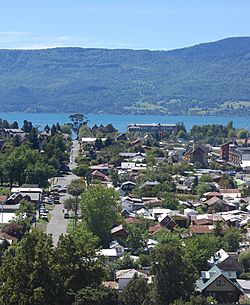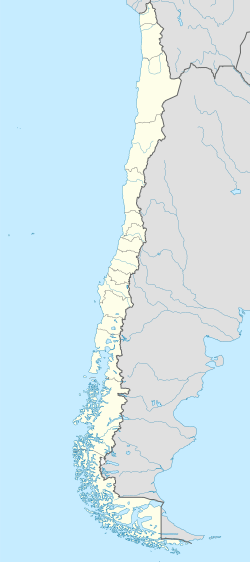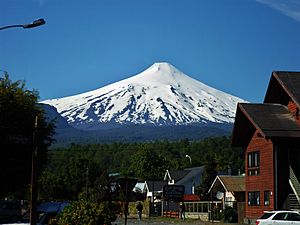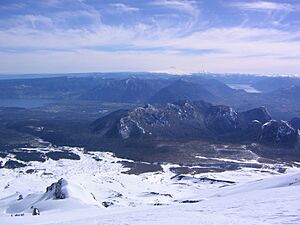Pucón facts for kids
Quick facts for kids
Pucón
|
||||||
|---|---|---|---|---|---|---|

View of Pucón along Lincoyán street and Villarrica Lake
|
||||||
|
||||||
| Country | Chile | |||||
| Region | Araucanía | |||||
| Province | Cautín | |||||
| Foundation | February 27, 1883 | |||||
| Government | ||||||
| • Type | Municipality | |||||
| Area | ||||||
| • City and Commune | 1,248.5 km2 (482.0 sq mi) | |||||
| Elevation | 227 m (745 ft) | |||||
| Population
(2012 Census)
|
||||||
| • City and Commune | 22,081 | |||||
| • Density | 17.6860/km2 (45.8066/sq mi) | |||||
| • Urban | 13,837 | |||||
| • Rural | 7,270 | |||||
| Sex | ||||||
| • Men | 10,705 | |||||
| • Women | 10,402 | |||||
| Time zone | UTC−4 (CLT) | |||||
| • Summer (DST) | UTC−3 (CLST) | |||||
| Area code(s) | country 56 + city 45 | |||||
Pucón is a beautiful Chilean city and commune. Its name comes from the Mapudungun language, meaning "entrance to the cordillera" (mountain range). Pucón is found in the Araucanía Region, about 100 km southeast of Temuco. It sits on the eastern shore of Lake Villarrica. The famous Villarrica volcano is only about 17 km south of the city.
Pucón is a very popular place for tourists. This is because of its amazing location by a lake and volcano. The weather is also quite good, especially in summer. Visitors can enjoy many exciting sports and activities. These include water skiing, snow skiing, backpacking, and white water rafting. You can also go kayaking, horse back riding, or visit natural hot springs. Other fun things are zip line rides, skydiving, and guided trips up Villarrica volcano.
Contents
History of Pucón
Early Settlements and Gold Mining
Long ago, during the conquest of Chile, the Spanish built a city called Villarrica in 1552. This was in the same area where Pucón is today. The Spanish were very interested in finding gold. They dug for gold in the ground around this city.
However, at some point in the 1500s, it seems that mudflows from the nearby Villarrica Volcano covered the gold mines. These mudflows are called lahars. Because of this, the settlers moved the city of Villarrica further west. The original spot, where Pucón now stands, was left empty.
Modern Pucón: A Fort and a Tourist Spot
The modern town of Pucón was started in 1883. It began as a fort after the Occupation of Araucanía. This was a time when the Chilean government took control of the Araucanía Region from the native people. Pucón was a good place for a fort. It was at the entrance of the Trancura Valley. This valley was important because the Argentinean army had once chased a group of Mapuches through it.
The first hotel in Pucón was the Gudenschwager, built in 1923. But tourism really took off in 1934 when the Gran Hotel Pucón opened. In 1940, the first road between Villarrica and Pucón was built. Later, in the 1970s, a road to Caburgua Lake was completed. These roads made it much easier for people to visit.
Population and Growth
Understanding Pucón's Demographics
In 2002, a census was done by the Chilean National Statistics Institute. This count showed that Pucón covers an area of about 1248.5 square kilometers. At that time, it had 21,107 people living there. This included 10,705 men and 10,402 women.
Most of the people, about 13,837 (65.6%), lived in the city's urban areas. The rest, 7,270 people (34.4%), lived in rural areas. The population of Pucón grew a lot between 1992 and 2002. It increased by 47%, which means 6,751 more people moved there.
Tourism and Activities
Pucón is a big hub for adventure tourism in Chile. Many visitors, both from Chile and other countries, come here. The area has amazing natural beauty, including volcanoes, lakes, waterfalls, and hot springs. This makes Pucón a great place to visit all year round.
In the summer, popular activities include hiking, rafting, and horseback riding. You can also go bird watching, fishing, or try canopy trails. In winter and spring, people enjoy skiing or snowboarding on the slopes of Villarrica volcano. There are also several thermal baths nearby in the Valdivian temperate rain forest.
It's easy to arrange these activities from the city. Pucón has many tourist offices and travel agencies. Even though the city area is small, there are lots of places to stay. You can find everything from hostels for backpackers to fancy hotels. Pucón also has many restaurants serving Chilean and international food. Recently, Pucón has become a popular place for people to buy second homes.
Popular Tourist Attractions
Villarrica Volcano: A Climber's Dream
Villarrica is the closest volcano to Pucón. Many people enjoy climbing it from the town. Other volcanoes nearby include Mocho-Choshuenco, Quetrupillán, and Lanín. Villarrica volcano has erupted more than 82 times since 1558. The most recent eruption was on March 3, 2015. You can climb it all year if the weather and volcano activity allow. In winter, the top is covered in snow, offering views of at least seven nearby lakes.
El Cañi: A Protected Nature Area
El Cañi means "sight that transforms." It is a special protected area of 500 hectares. It belongs to a non-profit group. Here, you can find hiking trails through old araucaria trees, lengas, and coigues. There are also old volcano craters and lagoons. Farmers manage this park.
The park is home to many animals. You might see foxes, pumas, and pudús (a small type of deer). Wild ducks and condors also live here. From a viewpoint at 1,550 meters high, you can see four nearby volcanoes: Villarrica, Quetrupillán, Lanín, and Llaima.
National Parks and Lakes
There are several amazing national parks in the area. These include Villarrica National Park, Huerquehue National Park, and Villarrica National Reserve. Some of the main lakes near Pucón are Villarrica, Caburgua, and Tinquilco.
The main river is the Trancura. This river is great for kayaking and rafting. It has different levels of difficulty. You can find easy family rides with Level III rapids. There are also more challenging rides with Level V rapids.
Relaxing Hot Springs
There are many hot springs and spas in and around Pucón. Some popular ones are Palguín, Rio Blanco, Huife, Quimey-Co, and Los Pozones. The nearby commune of Curarrehue also has great spas. These include Menetúe, San Luis, Trancura, Panqui, and Ancamil.
Understanding Lahar Risk Zones
Volcanic mudflows, called lahars, have happened often near Pucón and Villarrica volcano. In 1964, a lahar destroyed much of the town of Coñaripe.
A study in 2014 looked at the risk zones. It found that the international road east of the Pucón Airport is in a high-danger area. The road connecting Pucón to Villarrica to the west also has a high danger. The airport itself is in a low-danger zone. Most of the city area of Pucón is outside the possible paths for lahars.
Transportation in Pucón
The city has its own airport, Pucón Airport. This airport is big enough for planes like a Boeing 737 jet.
Images for kids
See also
 In Spanish: Pucón para niños
In Spanish: Pucón para niños








